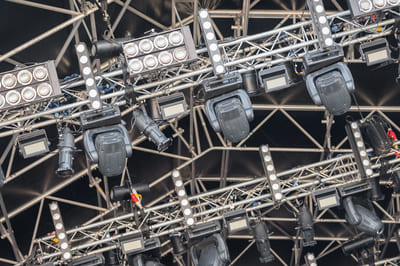The Importance of Using Quality Equipment
Stage rigging plays an important role in the success of a theater or music production. When you do not invest in quality stage rigging supplies or know what ones you need, it can have disastrous results.
For instance, in October 2018, the Tracy Byrd band was playing at the Brazoria Country Fair in Texas when its stage rigging equipment failed. One of the massive stage lights fell directly onto the keyboard player. The falling light injured the keyboardist and the venue had to cancel the rest of the performances.
Invest in high-quality stage rigging so your theater production does not face similar issues. Learn more about theater rigging and some common types of rigging equipment below.
Why Use Stage Rigging?
 Stage rigging provides two basic things:
Stage rigging provides two basic things:
- A support for the stage-lighting equipment.
- Support and allowance of movement for the stage scenery.
Normally, a stage-lighting system has many outlets that dim individually. This depends on the types of performance-lighting fixtures that connect to it.
Each of these light fixtures may weight up to 40 pounds each, sometimes more. Even small productions use around 300+ specialty fixtures. And each of those fixtures is supported by the theater rigging. When more than half of those hang over your actors on the stage, you need to know you can trust the rigging is safe.
The same applies to all the scenery, like backdrops, stage curtains, framed scenes, and when you move parts of the scenery up or down during the play.
Plays often feature more than one locale, so you may need to change various backdrop elements during the performance. The faster and quieter you can accomplish this, the less you break the fourth wall.
Equipment in Various Types of Stage Rigging Systems
The theater rigging structure you build must support each of the heavy, moving elements that make up the rigging system. The most common parts of stage rigging structures include those listed below.
Fly Tower with Rigging
The fly tower refers to the space above the stage's performance area. It houses the stage rigging equipment in the area enclosed around the stage. This area is known as the stage house. A fly tower may or may not include a gridiron.
Gridiron
A type of permanent stage rigging system, a gridiron is a secured work floor located above the stage attached to the fly tower. It supports the fundamental, upright rigging by holding the blocks that support any live load on the fly tower.
The gridiron supports secondary rigging for your production as well. This includes spot blocks or chain hosts installed temporarily to support specified point loads, like heavy lighting trusses. It also supports equipment used for flying in a performance.
Headwell
The headwell plays an important role in manually operated rigging systems using steel counterweights. The vector point where the rope lines pass through the single pulley (the head block) attaches to the vital headwell.
The headwell must be strong enough to hold up both the lifted item and the steel weights.
Motorized Rigging Systems
Theater productions on cruise ships often need a motorized rigging system. This is because they do not have much space on deck or backstage.
These systems are more common in Europe, and productions in the U.S. usually use motorized systems for lifting very heavy loads. They also use them when the same movement must occur the same way multiple times during a production.
Invest in Quality Stage Rigging Equipment
Never underestimate the importance of good, quality stage rigging. The best stage rigging equipment operates smoothly with less intrusive sound. It also keeps your actors and stagehands safe.
The engineers at PFlow offer stage-rigging material lifting solutions for production managers throughout the United States. Contact us today to see if a hydraulic lift or a vertical lift will benefit the set-up of your next theater production.
